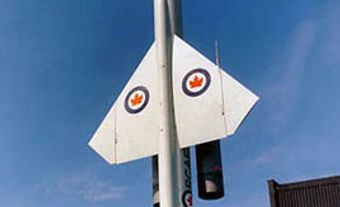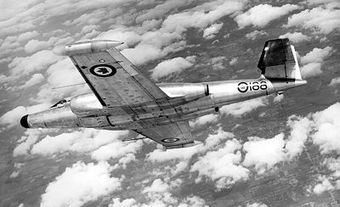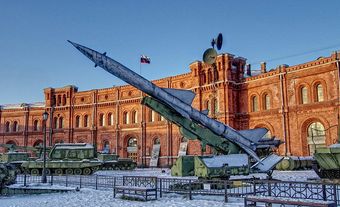The North American Aerospace Defense Command (NORAD) was a pact made in 1957, at the height of the Cold War. It placed under joint command the air forces of Canada and the United States. Its name was changed in 1981 to the North American Aerospace Defense Command, but it kept the NORAD acronym. Canada and the US renewed NORAD in 2006, making the arrangement permanent. It is subject to review every four years, or at the request of either country. NORAD’s mission was also expanded into maritime warnings. The naval forces of the two countries remain under separate commands.

Cold War Fears
On 1 August 1957, the Canadian and American governments announced the two countries would integrate their air-defence forces under a joint command at Colorado Springs, Colorado. The Cold War between the Soviet Union and Western nations was well underway. Both Canada and the US feared long-range Soviet attack. The Royal Canadian Air Force (RCAF) and the United States Air Force (USAF) would work together to ensure continental protection. (See also Continentalism.)
NORAD describes itself as providing aerospace defence. This “includes the detection, validation, and warning of attack against North America whether by aircraft, missiles, or space vehicles.”
Controversies
NORAD has occasionally been a focus of controversy. In 1957, Prime Minister John Diefenbaker and National Defense Minister George Pearkes, just installed in office, hastily accepted the advice of the Canadian military; they agreed to integrate the RCAF with the USAF for the air defence of the continent. Critics felt the decision was taken without adequate preparation. (The formal signing did not take place until 12 May 1958, one indication of subsequent concerns.) The Conservative Diefenbaker government was roasted by the Liberal opposition for its haste.
Technically, the agreement has been a success. It has coordinated two air forces in pursuit of a difficult mission. It has also kept Canadian air crews in line with NORAD doctrine and policy. However, because the consent of both governments is required before any formal alerts or action, there has sometimes been difficulty in implementation; most notably in 1962 during the Cuban Missile Crisis. The American military went on standby alert in 1962 as soon as the crisis was apparent. The Canadian government, however, delayed for several days. This angered the administration of US President John F. Kennedy. It also provoked much criticism in Canada.

Cheyenne Mountain and Peterson AFB
In 1966, NORAD’s command moved into the Cheyenne Mountain Operations Center. It is a giant bunker complex situated underground near Colorado Springs. It remained the main headquarters until 2006. The command centre then moved to nearby Peterson Air Force Base. The Cheyenne Mountain complex became a backup command centre.
NORAD has been maintained by successive governments. The renaming of the command in 1981 reflected a new emphasis on defence and warning against missiles. (See also Early-Warning Radar.) The advent of cruise missiles also increased NORAD’s necessity. The Canadian government recognized this in 1985 by replacing the Distant Early Warning (DEW) Line that had been built in the 1950s with the North Warning System. It is a series of radar installations across the Canadian North. (See also Qikiqtarjuaq.)
In response to changing threats and the collapse of the Soviet Union in 1991, the United States began moving its warning, detection and surveillance into space. (See Space Technology.) This shift in emphasis lessened the importance of Canadian geography in the overall North American aerospace defence strategy. A 1992 NORAD strategy review said that while the Soviet Union no longer existed, its successor states, primarily Russia, still had the weapons NORAD was designed to protect against. The review also flagged the threat of a possible terrorist attack with cruise missiles or similar weaponry.
2001 Terror Attacks
Immediately after the September 2001 terror attacks in the US, NORAD started Operation Noble Eagle. It aims to protect North American airspace against further such events. NORAD responded to 2,100 potential threats by June 2006 and flew 42,000 sorties with military aircraft.
In 2006, Canada and the US renewed NORAD. The new pact made the arrangement permanent, subject to review every four years, or at the request of either country. It also expanded NORAD’s mission into maritime (ocean) warnings; although the naval forces of the two countries remain under separate commands.
In 2009, NORAD monitored North Korean nuclear and missile tests. It decided the tests posed no immediate threat. NORAD also provided air security at the 2010 Olympic Winter Games in Vancouver. It has provided similar protection to NASA space shuttle launches, to G8 summit meetings and to Super Bowl football games.
In 2012, NORAD renamed its headquarters at Peterson Air Force Base the Eberhart-Findley Building, after both an American general and RCAF Lieutenant-General Eric Findley. Findley was the first Canadian military officer to have his name used for a US military command centre.
See also Bomarc Missile Crisis; Avro CF-100 Canuck.

 Share on Facebook
Share on Facebook Share on X
Share on X Share by Email
Share by Email Share on Google Classroom
Share on Google Classroom



